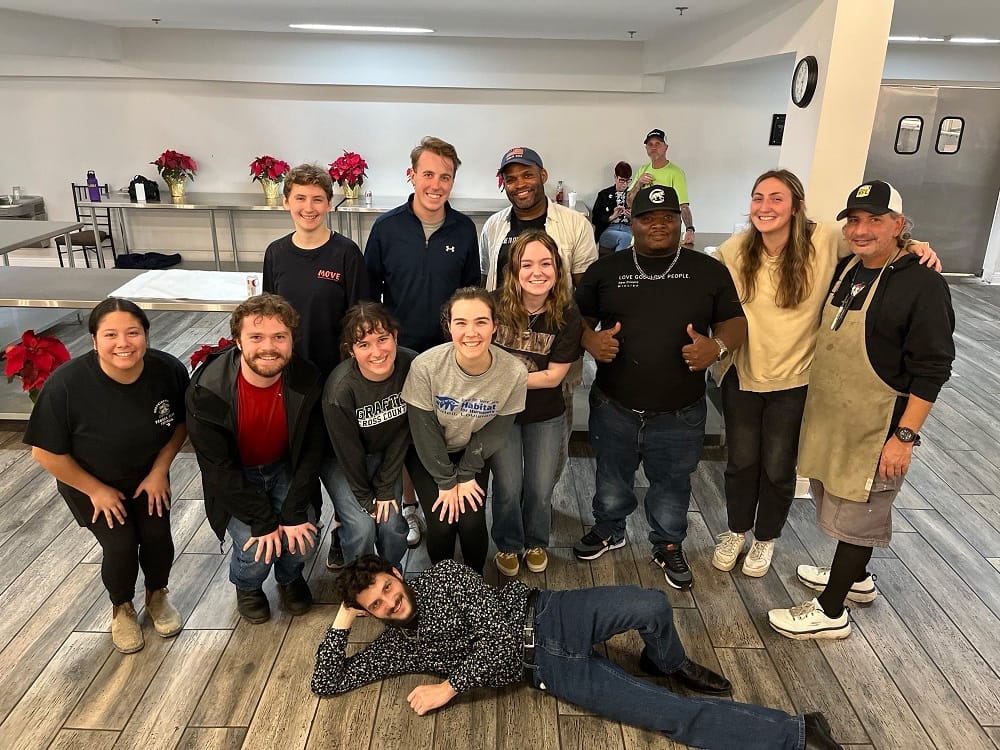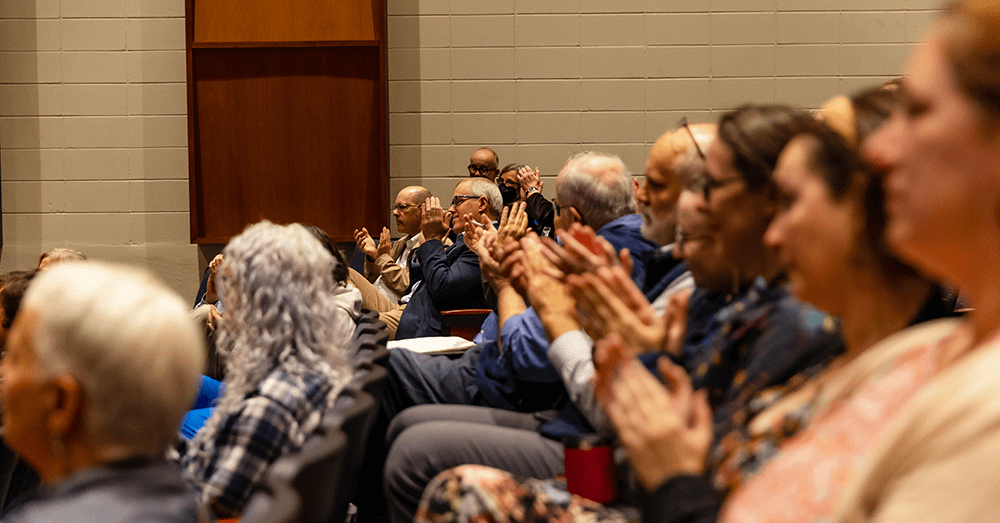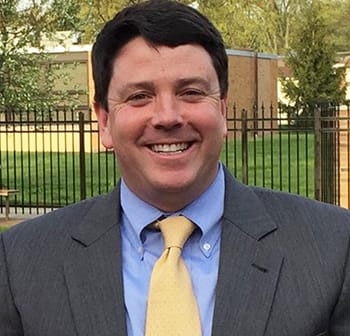Wildlife researchers advance efforts
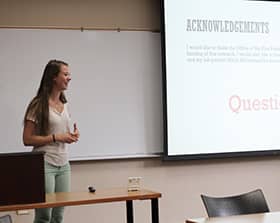
The header photo shows Dagan Loisel of the Saint Michael’s biology faculty addressing the group. Directly above, Saint Michael’s student researcher Emily Ferreri speaks. Images below show Vermont Genetics Network Director Rex Forehand (right); two presenter from Middlebury, Saint Michael’s student researcher Mitch McDonald; and a group listening from the audience including Bill Landesman of Green Mountain College. (photos by Danielle Joubert ’20)
Faculty and students from five Vermont colleges met at Saint Michael’s on Wednesday, July 25 to share their research on wildlife disease and related subjects. While the diseases in question were studied in animals, the meeting addressed some major human concerns. A large portion of the day was spent discussing Lyme disease’s virility, distribution, and what makes the disease “tick” on a genetic level. Swimmer’s itch was also on the table, along with bobcat gamma herpesvirus research that could be connected to HIV and its feline equivalent in domestic cats, FIV.
Attendees gathered in Jeanmarie Hall for nearly a full day of talking methods, data, and potential moves to make in the future of studying wildlife pathology. After each student and faculty presentation, the group launched into conversation about the dizzying details, such as techniques for DNA extraction and statistical analysis, contamination prevention, and ways to extend the current research. Representatives came from Saint Michael’s College, The University of Vermont, Middlebury College, Green Mountain College, and Norwich College.
The meeting was sponsored by The Vermont Genetics Network, which also provided funding for most of the research under discussion. VGN director Rex Forehand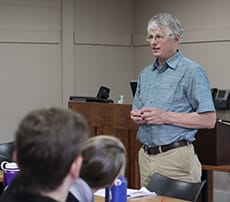 shared his goal to “create thematic groups” of researchers across the state, bringing them together to share their work. “The major reason for this,” said Forehand, “is that in many of the institutions that you’re from, people don’t really have the opportunity to talk with other faculty and other students about their research. And it may overlap more with somebody from (another Vermont) university than somebody else in your own institution.”
shared his goal to “create thematic groups” of researchers across the state, bringing them together to share their work. “The major reason for this,” said Forehand, “is that in many of the institutions that you’re from, people don’t really have the opportunity to talk with other faculty and other students about their research. And it may overlap more with somebody from (another Vermont) university than somebody else in your own institution.”
The research from Wednesday’s working group has seen students and their professors trekking through the Vermont landscape, gathering ticks and snails for analysis of the pathogens they carry. Yet their work is significant not just in Vermont, but for painting a national portrait of American wildlife pathology, ecology and even evolutionary history. Also present was Professor Mollie Jewett from the University of Central Florida, presenting her findings on the genetic factors that allow Lyme disease to survive within a host. Researchers from Middlebury were examining potentially universal factors in Lyme disease virility such as humidity and elevation, as well as presenting a new method of calculating the R0 figure that describes the rate of viral replication. Research led by St. Mike’s professor Dagan Loisel has involved collaboration with researchers in California, Colorado, Florida, and even Germany.
Loisel’s work examining bobcat Gammaherpesvirus has focused on a specific antiviral gene in the felines known as APOBEC3H (abbreviated as A3H) that also has implications for resistance or susceptibility to Human Imminodeficiency Virus (HIV) in people, as well as resistance to the feline equivalent FIV in domestic cats. Research sub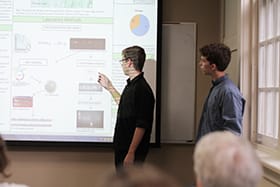
Loisel said that 91 percent of the Vermont bobcats studied that were over the age of two years were infected with the virus, as well as 46 percent of bobcats younger than two. Herpesvirus is also extremely common in humans. Between 60 percent and 90 percent of people are infected with the virus in some latent form, but human strains are largely harmless as well. They remain dormant in most cases. It’s when a herpes virus is activated in an immunocompromised host that it can cause serious damage, namely a variety of tumors and cancers such as B cell lymphomas, Hodgkin’s and non-Hodgkin’s lymphomas, nasopharyngeal and gastric carcinomas, and some others. The Epstein-Barr herpesvirus in particular can cause the infectious illness most commonly known as mono.
Through his collaboration with other researchers across the United States, Loisel has found that this A3H gene in Vermont is extremely similar to that of Florida bobcats, but is different from those found in bobcats out west in California and Colorado. These findings suggest East and West Coast variations that could help us to understand the evolution of bobcats across the United States with further exploration. Overall, the research at Saint Michael’s helps to fill a gap in New England bobcat data that enhances a holistic national analysis of their pathology.
Emily Ferreri and Mitch McDonald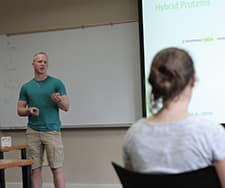
Meetings like this one are a major step in expanding the potential of undergraduate research at all of the institutions involved. “One of the goals of this and future meetings is to identify research questions or techniques that are similar in the different labs,” said Professor Loisel. “That way, we can help each other to generate results, share research equipment and methods, and provide feedback on grant applications and research manuscripts. We may also be able to work together to develop new research projects.” Faculty and students studying genetics and immunology at Saint Michael’s can look forward to branching out into a larger scientific community through this new avenue of sharing resources and ideas.
Faculty presentations:
Dave Allen, Middlebury College: Calculating Lyme Disease R0 using a next-generation matrix model
Mollie Jewett, University of Central Florida: Uncovering the genetic basis for Borrelia burgdorferi infectivity
Bill Landesman, Green Mountain College: The role of the Ixodes scapularis microbiome in disease transmission
Dagan Loisel, Saint Michael’s College: Genetic identity and prevalence of herpesvirus in wild VT bobcats
Allison Neal, Norwich University: The Norwich Ecological Associations Lab: exploring the ecology and evolution of lizard malaria and Vermont trematodes
Joe Schall, University of Vermont: Two ways to do it (with difficulty) – horizontal and vertical transmission

